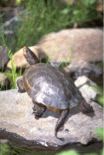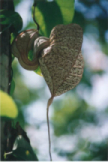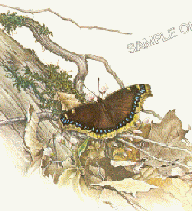Docent Circle: Field Notes Week of 2005-05-01
 Female western
pond turtles plod away from their ponds, marshes, and streams
sometime between May and July to lay clutches of 1 to 13 eggs.
Although she may wander more than a mile in search of a suitable
nest site, a female typically buries her eggs in well-drained soil
close to the water's edge.
Female western
pond turtles plod away from their ponds, marshes, and streams
sometime between May and July to lay clutches of 1 to 13 eggs.
Although she may wander more than a mile in search of a suitable
nest site, a female typically buries her eggs in well-drained soil
close to the water's edge.
When the young hatch three to four months
later, they head back to the water, where they often end up as
snacks for bullfrogs and bass, introduced species whose appetites
are tipping various natives toward extinction. Once found
throughout most of the state, the turtles are rapidly losing ground
to alien species and habitat destruction. A pond turtle spends much
of the day basking in the sun and maintaining its body temperature.
But the moment it senses a predator coming, the canny creature
drops from its log or pondweed perch and disappears under the
water. If you hope to see a pond turtle in the wild, get in the
habit of sneaking up on bodies of water. Watch for western pond
turtles perched on logs in the water in the ponds and channels of
the laguna.
 Monterey north,
California dutchman's pipe is displaying its odd,
pipe-shaped, cream-colored flowers. It then grows many large
heart-shaped leaves, the exclusive food of
Monterey north,
California dutchman's pipe is displaying its odd,
pipe-shaped, cream-colored flowers. It then grows many large
heart-shaped leaves, the exclusive food of
 pipevine swallowtail larvae.
pipevine swallowtail larvae.
Be alert for a
glimpse of the stunning, purplish-black adult butterfly.
Another striking dark butterfly and one of the
earliest to appear in spring is the common mourning
cloak,
with its dark brown wings edged in yellow. Known as the
Camberwell beauty in England, this butterfly relies on cotton-woods,
willows, and elms for food.
 Dusky-footed
woodrats give birth to litters of one to four young during
winter and spring. Until they are weaned at three weeks, baby
woodrats keep their mouths clamped tightly around their mother's
teats when she's in the nest. That way, if mom needs to make an
emergency exit, she drags the little ones with her. The ranges of
California's four woodrat species virtually blanket the state.
These gentle rodents build large, conical nests of sticks, leaves,
paper, and any other debris they can pull across the ground.
Beneath the sticks, woodrats construct separate chambers for
living, rearing young, storage, and waste. Succeeding generations
of woodrats keep adding to their quarters, which can grow to eight
feet in diameter and the height of an adult. Have you spied a wood
rat nest in the Laguna? According to some, if you've never
seen one of these nests, you haven't been looking. Next time you're
in the hills or woods, peer into the brush and blackberry patches
or around the bases of lightning-hollowed trees for these messy
piles of sticks and twigs.
Dusky-footed
woodrats give birth to litters of one to four young during
winter and spring. Until they are weaned at three weeks, baby
woodrats keep their mouths clamped tightly around their mother's
teats when she's in the nest. That way, if mom needs to make an
emergency exit, she drags the little ones with her. The ranges of
California's four woodrat species virtually blanket the state.
These gentle rodents build large, conical nests of sticks, leaves,
paper, and any other debris they can pull across the ground.
Beneath the sticks, woodrats construct separate chambers for
living, rearing young, storage, and waste. Succeeding generations
of woodrats keep adding to their quarters, which can grow to eight
feet in diameter and the height of an adult. Have you spied a wood
rat nest in the Laguna? According to some, if you've never
seen one of these nests, you haven't been looking. Next time you're
in the hills or woods, peer into the brush and blackberry patches
or around the bases of lightning-hollowed trees for these messy
piles of sticks and twigs.
From Joseph Cornell's Sharing Nature with
Children: Flow Learning: making it work for
you. "When you introduce people to nature with playful
activities that energize body and mind, the high energy that the
games develop washes away personal problems and moods. Freed
from personal worries, their enthusiasm and attention can flow into
new and fascinating experiences."
As docents, the gift we can bring to the children is our
questioning, explorative nature and our pure enthusiasm for the
discoveries we make together.
Back to the Field Notes Archive
 Female western
pond turtles plod away from their ponds, marshes, and streams
sometime between May and July to lay clutches of 1 to 13 eggs.
Although she may wander more than a mile in search of a suitable
nest site, a female typically buries her eggs in well-drained soil
close to the water's edge.
Female western
pond turtles plod away from their ponds, marshes, and streams
sometime between May and July to lay clutches of 1 to 13 eggs.
Although she may wander more than a mile in search of a suitable
nest site, a female typically buries her eggs in well-drained soil
close to the water's edge. Monterey north,
California dutchman's pipe is displaying its odd,
pipe-shaped, cream-colored flowers. It then grows many large
heart-shaped leaves, the exclusive food of
Monterey north,
California dutchman's pipe is displaying its odd,
pipe-shaped, cream-colored flowers. It then grows many large
heart-shaped leaves, the exclusive food of
 pipevine swallowtail larvae.
pipevine swallowtail larvae.
 Dusky-footed
woodrats give birth to litters of one to four young during
winter and spring. Until they are weaned at three weeks, baby
woodrats keep their mouths clamped tightly around their mother's
teats when she's in the nest. That way, if mom needs to make an
emergency exit, she drags the little ones with her. The ranges of
California's four woodrat species virtually blanket the state.
These gentle rodents build large, conical nests of sticks, leaves,
paper, and any other debris they can pull across the ground.
Beneath the sticks, woodrats construct separate chambers for
living, rearing young, storage, and waste. Succeeding generations
of woodrats keep adding to their quarters, which can grow to eight
feet in diameter and the height of an adult. Have you spied a wood
rat nest in the Laguna? According to some, if you've never
seen one of these nests, you haven't been looking. Next time you're
in the hills or woods, peer into the brush and blackberry patches
or around the bases of lightning-hollowed trees for these messy
piles of sticks and twigs.
Dusky-footed
woodrats give birth to litters of one to four young during
winter and spring. Until they are weaned at three weeks, baby
woodrats keep their mouths clamped tightly around their mother's
teats when she's in the nest. That way, if mom needs to make an
emergency exit, she drags the little ones with her. The ranges of
California's four woodrat species virtually blanket the state.
These gentle rodents build large, conical nests of sticks, leaves,
paper, and any other debris they can pull across the ground.
Beneath the sticks, woodrats construct separate chambers for
living, rearing young, storage, and waste. Succeeding generations
of woodrats keep adding to their quarters, which can grow to eight
feet in diameter and the height of an adult. Have you spied a wood
rat nest in the Laguna? According to some, if you've never
seen one of these nests, you haven't been looking. Next time you're
in the hills or woods, peer into the brush and blackberry patches
or around the bases of lightning-hollowed trees for these messy
piles of sticks and twigs.